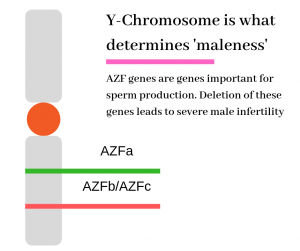Hello!
Vanakkam and Welcome to Dr. Shah’s Clinic for Male Infertility & Sexual Health. This is Dr. Shah here and I am an Andrology doctor in Chennai, I primarily specialize in treating complicated problems with men’s reproductive health.
In this awesome round-up article, I am going to deconstruct all the possible causes of male infertility. Don’t stop reading! this article will open your mind, keep reading!
So…
What is the inormal sperm motility for pregnancy?. Well here again data from fertile men (actually mostly European men, we don’t have Indian data!…a very bad joke actually) indicates that men with progressive sperm motility of 32% and above had no issues in fathering a child in the 1st year of marriage. Here again, a man is said to have low sperm motility (also referred to as Asthenozoospermia) if his motility values fall below 32%.
A good sperm is one that appears perfect like below. Most importantly men who father children in the first year of marriage should have at least 3% to 4% of these so-called ‘normal appearing sperm’. If you have anything less, then you are probably a candidate for male infertility issues (as per the recommended guidelines). However, sperm morphology estimation and the right estimation of sperm morphology itself is highly debated.
 A great degree of variation exists among laboratories in the methods of estimating sperm morphology. What’s worse?. An even greater degree of variation exists among the laboratory Andrologists who are actually doing the morphology estimation. In my clinical practice, I have seen numerous patients who come with a report that states ‘Low normal morphology’ only to find later on retesting that, these guys were completely normal!!.
A great degree of variation exists among laboratories in the methods of estimating sperm morphology. What’s worse?. An even greater degree of variation exists among the laboratory Andrologists who are actually doing the morphology estimation. In my clinical practice, I have seen numerous patients who come with a report that states ‘Low normal morphology’ only to find later on retesting that, these guys were completely normal!!.
 Sperm production stops or slowly comes to a stop. Men with Y-chromosome microdeletion will usually have a range of semen parameter abnormalities. Sperm counts for these men can usually range from 0 to 1 million/ml usually.
Sperm production stops or slowly comes to a stop. Men with Y-chromosome microdeletion will usually have a range of semen parameter abnormalities. Sperm counts for these men can usually range from 0 to 1 million/ml usually.
 Sadly, this condition is not treatable in adulthood. A patient who has both testis that are not descended late into adulthood are permanently sterile.
However, some patients will have only testis in the sac while the other will be somewhere in the abdomen or lower down in the inguinal canal. For these patients, if the normally positioned testis is functionally properly, they should have no issues with fertility. A proper semen test, physical exam, hormone assessment, and scan are usually required.
What’s also important to bear in mind is that, if in adulthood an undescended testis is discovered it must and should be promptly removed. This is because of the risk of testicular cancer developing in the undescended testis.
J. Testicular Infections:-
Among male infertility causes, testicular infections deserve a special mention. Interestingly, sexually transmitted diseases can lead to testicular infections and in worse scenarios a blockage.
Thinking about unprotected contact? think twice!!. I cannot emphasize enough the importance of a stable marital relationship with one partner for life. I have personally seen too many men enjoy excessive sexual freedom (of course they justify it through their nose) and suffer the consequences.
Infections like Gonorrhoea, Chlamydia, and Syphilis can all severely affect the male reproductive system in multiple unknown ways. From impairing sperm motility and sperm production, all the way up to causing blocks in the epidydimis (the biological storage closet for sperm above the testis), these little germs can do it all.
Sadly, this condition is not treatable in adulthood. A patient who has both testis that are not descended late into adulthood are permanently sterile.
However, some patients will have only testis in the sac while the other will be somewhere in the abdomen or lower down in the inguinal canal. For these patients, if the normally positioned testis is functionally properly, they should have no issues with fertility. A proper semen test, physical exam, hormone assessment, and scan are usually required.
What’s also important to bear in mind is that, if in adulthood an undescended testis is discovered it must and should be promptly removed. This is because of the risk of testicular cancer developing in the undescended testis.
J. Testicular Infections:-
Among male infertility causes, testicular infections deserve a special mention. Interestingly, sexually transmitted diseases can lead to testicular infections and in worse scenarios a blockage.
Thinking about unprotected contact? think twice!!. I cannot emphasize enough the importance of a stable marital relationship with one partner for life. I have personally seen too many men enjoy excessive sexual freedom (of course they justify it through their nose) and suffer the consequences.
Infections like Gonorrhoea, Chlamydia, and Syphilis can all severely affect the male reproductive system in multiple unknown ways. From impairing sperm motility and sperm production, all the way up to causing blocks in the epidydimis (the biological storage closet for sperm above the testis), these little germs can do it all.
Why male infertility?
Well, the answer is fairly straightforward. Male reproductive health issues are not efficiently addressed as compared to other medical specialties in our country. Pretty sad actually! worse yet, even a large majority of fertility clinics are focussing on the female partner without even bothering strictly with the male. There is now strong, and I mean very strong scientific data to suggest that infertility is now a global problem and affects 1 in 10 married couples. A male-factor cause of infertility is frequently seen in about 40 to 50% of all patients suffering from fertility problems, now this is no small number, by any chance!. WHO estimates over 250 million couples world-over suffering from fertility issues at any point in time, imagine 50% of that solely due to a male partner problem.Let me cut to chase, now that you have understood the seriousness of the issue in hand. So, what are the causes of male infertility?
A. Low sperm count
The normal sperm count for men who father children within the 1st year of marriage ranges from 13 to 15 million/ml. A large proportion of men suffer from male infertility due to low sperm count issues. A man said to have low sperm count problems (also referred to as Oligozoospermia) if his count measured twice with a semen analysis shows a value of less than 15 million/ml. Remember, I said twice!, One measurement really does not mean anything. So chill!. B.Low sperm motility
B.Low sperm motility
What is the inormal sperm motility for pregnancy?. Well here again data from fertile men (actually mostly European men, we don’t have Indian data!…a very bad joke actually) indicates that men with progressive sperm motility of 32% and above had no issues in fathering a child in the 1st year of marriage. Here again, a man is said to have low sperm motility (also referred to as Asthenozoospermia) if his motility values fall below 32%.
 C. Abnormal Sperm morphology
C. Abnormal Sperm morphology
A good sperm is one that appears perfect like below. Most importantly men who father children in the first year of marriage should have at least 3% to 4% of these so-called ‘normal appearing sperm’. If you have anything less, then you are probably a candidate for male infertility issues (as per the recommended guidelines). However, sperm morphology estimation and the right estimation of sperm morphology itself is highly debated.
 A great degree of variation exists among laboratories in the methods of estimating sperm morphology. What’s worse?. An even greater degree of variation exists among the laboratory Andrologists who are actually doing the morphology estimation. In my clinical practice, I have seen numerous patients who come with a report that states ‘Low normal morphology’ only to find later on retesting that, these guys were completely normal!!.
A great degree of variation exists among laboratories in the methods of estimating sperm morphology. What’s worse?. An even greater degree of variation exists among the laboratory Andrologists who are actually doing the morphology estimation. In my clinical practice, I have seen numerous patients who come with a report that states ‘Low normal morphology’ only to find later on retesting that, these guys were completely normal!!.
Okay, here is next set of causes of male infertility
D. Multiple semen parameter defects:-
Over 20% all men presently to a fertility clinic, would usually have a combination of problems in the semen test. This typically means the person could have both low sperm concentration + low sperm motility or a combination of all three, that is low sperm concentration + low sperm motility + low normal sperm morphology. Phew!. In the event, such a patient has a problem with all the 3 semen parameters a diagnosis of OATS is made. A condition called Oligoasthenoteratozoospermia. OATS is a fairly common clinical condition and is a very notorious cause of male infertility that requires active hormonal assessment and imaging studies.E. Low semen volume:-
Interestingly many men who come to my clinic, come with a very common complaint that their semen volume is low. Low semen volume issues are again a common cause of male infertility. A low semen volume issue is not something to be ignored…ever!. Men with low semen volume may be suffering from Hypogonadotropic hypogonadism (as we will see shortly), retrograde ejaculation, or sometimes just plain erectile dysfunction (another menace in itself).F. Hypgonadotrophic Hypogonadism
Patients with Hypogonadotropic hypogonadism suffer from severe male infertility. They are usually tall, obese and have sparse hair distribution. A proper diagnosis of course also involves a thorough clinical examination, along with checking the male sex hormones (all of it) along with a semen analysis (done twice). Such patients, frequently present with Azoospermia (no sperm in semen). In these patients, the testis is very small and soft. Erectile dysfunction and low sex interest is also seen in most if not all patientsG. Klinefelter’s Syndrome
This is a genetic condition and affects about 0.5 % of men as a cause of male infertility. These patients are again obese, have very poor hair distribution and testis that is usually soft and firm. Once again a semen analysis will show Azoospermia and all these patients will require aggressive fertility therapies. In these patients, the testis (which is the site of sperm production and testosterone synthesis) fails completely during puberty itself. Here again, it’s not surprising to see men with severe erectile dysfunction and/or low sex interestH. Testicular Failure due to Y-Chromosome Microdeletion:-
Y-chromosome microdeletion is on the top or most common genetic cause of male infertility issues. The Y-chromosome contains THE most important set of genes (what are genes? well, they are bits of information stored in your DNA much like a computer code/program that makes a computer work) that are required for sperm production. When a gene or set of genes are deleted, what happens?, well the code breaks!. and the hardware crashes (in this case we are referring to the testis specifically). Sperm production stops or slowly comes to a stop. Men with Y-chromosome microdeletion will usually have a range of semen parameter abnormalities. Sperm counts for these men can usually range from 0 to 1 million/ml usually.
Sperm production stops or slowly comes to a stop. Men with Y-chromosome microdeletion will usually have a range of semen parameter abnormalities. Sperm counts for these men can usually range from 0 to 1 million/ml usually.
I. The testis that refused to descent (Undescended testis)
“And God said man should descend down from the heavens”Well, I will try my best to keep religious references out, but I can’t help it. In about 5% of men who present to a fertility clinic, the undescended testis is seen. Now, the testis normally completes descent by birth. When a male baby is developing in the womb of the mother, testicular descent occurs, a rather complex process, the testis moves from somewhere in the abdomen and comes to occupy a position much lower down in the scrotum (the bags that hold both testis). In some men, this process gets impaired. In these men, the testis does not descent. It remains in the abdomen and is frequently missed post birth (possibly by the overconfident/undertrained paediatrician or gynaecologist)
 Sadly, this condition is not treatable in adulthood. A patient who has both testis that are not descended late into adulthood are permanently sterile.
However, some patients will have only testis in the sac while the other will be somewhere in the abdomen or lower down in the inguinal canal. For these patients, if the normally positioned testis is functionally properly, they should have no issues with fertility. A proper semen test, physical exam, hormone assessment, and scan are usually required.
What’s also important to bear in mind is that, if in adulthood an undescended testis is discovered it must and should be promptly removed. This is because of the risk of testicular cancer developing in the undescended testis.
J. Testicular Infections:-
Among male infertility causes, testicular infections deserve a special mention. Interestingly, sexually transmitted diseases can lead to testicular infections and in worse scenarios a blockage.
Thinking about unprotected contact? think twice!!. I cannot emphasize enough the importance of a stable marital relationship with one partner for life. I have personally seen too many men enjoy excessive sexual freedom (of course they justify it through their nose) and suffer the consequences.
Infections like Gonorrhoea, Chlamydia, and Syphilis can all severely affect the male reproductive system in multiple unknown ways. From impairing sperm motility and sperm production, all the way up to causing blocks in the epidydimis (the biological storage closet for sperm above the testis), these little germs can do it all.
Sadly, this condition is not treatable in adulthood. A patient who has both testis that are not descended late into adulthood are permanently sterile.
However, some patients will have only testis in the sac while the other will be somewhere in the abdomen or lower down in the inguinal canal. For these patients, if the normally positioned testis is functionally properly, they should have no issues with fertility. A proper semen test, physical exam, hormone assessment, and scan are usually required.
What’s also important to bear in mind is that, if in adulthood an undescended testis is discovered it must and should be promptly removed. This is because of the risk of testicular cancer developing in the undescended testis.
J. Testicular Infections:-
Among male infertility causes, testicular infections deserve a special mention. Interestingly, sexually transmitted diseases can lead to testicular infections and in worse scenarios a blockage.
Thinking about unprotected contact? think twice!!. I cannot emphasize enough the importance of a stable marital relationship with one partner for life. I have personally seen too many men enjoy excessive sexual freedom (of course they justify it through their nose) and suffer the consequences.
Infections like Gonorrhoea, Chlamydia, and Syphilis can all severely affect the male reproductive system in multiple unknown ways. From impairing sperm motility and sperm production, all the way up to causing blocks in the epidydimis (the biological storage closet for sperm above the testis), these little germs can do it all.
K. Phimosis:-
So what is a Phimosis? Well, it’s basically a condition where a male is unable to retract his foreskin over the glans of the penis. In this condition, due to anatomical dead space created between the foreskin and glan’s of the penis, semen deposition in the vagina does not properly during sexual intercourse. As a result, fertility issues can arise. What’s worse? well, men with tight foreskin issues frequently suffer from severe pain during attempted penetration, erection disorders. In some worse case scenarios, I have seen couples married over long years with an inability to consummate the marriage itself. A Phimosis needs to be treated properly and promptly. Treatments are fairly straightforwardL. Erectile Dysfunction:-
Erectile dysfunction is a very common cause of male infertility at least in our country. Many patients with erectile dysfunction suffer silently for years before taking active treatment. Most interestingly, numerous scientific studies (as well as what I have seen in my clinical practice as a sexologist) have clearly suggested that, in patients with erection problems, diabetes, uncontrolled cholesterol and hypertension exists. But that’s not the worst of it. Erectile Dysfunction not only causes male infertility but also leads to long term coronary artery disease.M. Premature Ejaculation (PME):-
Again another common issue leading to fertility problems in a few men, some men ejaculate before penetration, during foreplay itself. In these severe cases of premature ejaculation, semen deposition happens outside rather than inside the vagina leading to fertility issuesN. Masturbation addiction:-
Well, what can I say?. Some men just want to do it alone. Men who are addicted to masturbatory practices will frequently avoid normal sexual intercourse with their partners for years together. Frequently, men with these kinds of behavioral problems find a great deal of gratification with the variety they get from masturbating to pornographic content. Most of these patterns of masturbatory behavior start very early for men with these addiction patterns. Masturbation addiction, however, is treatable. So, is that it?. Well no!. Given below are a list of conditions that associated with male infertility (remember association is very different from causation!).Associated causes of male infertility:-
-
Varicocele:-
-
Smoking and Alcohol
-
Medication Use
-
Drug abuse
-
Obesity
-
Occupational Exposure
-
Sperm DNA fragmentation
- O’Brien KL, Varghese AC, Agarwal A. The genetic causes of male factor infertility: a review. Fertility and sterility. 2010 Jan 1;93(1):1-2
- Pandiyan N, Khan SD. A clinical approach to male infertility. InMale Infertility 2017 (pp. 41-54). Springer, New Delhi.
- Zini A, Bielecki R, Phang D, Zenzes MT. Correlations between two markers of sperm DNA integrity, DNA denaturation and DNA fragmentation, in fertile and infertile men. Fertility and sterility. 2001 Apr 1;75(4):674-7.
